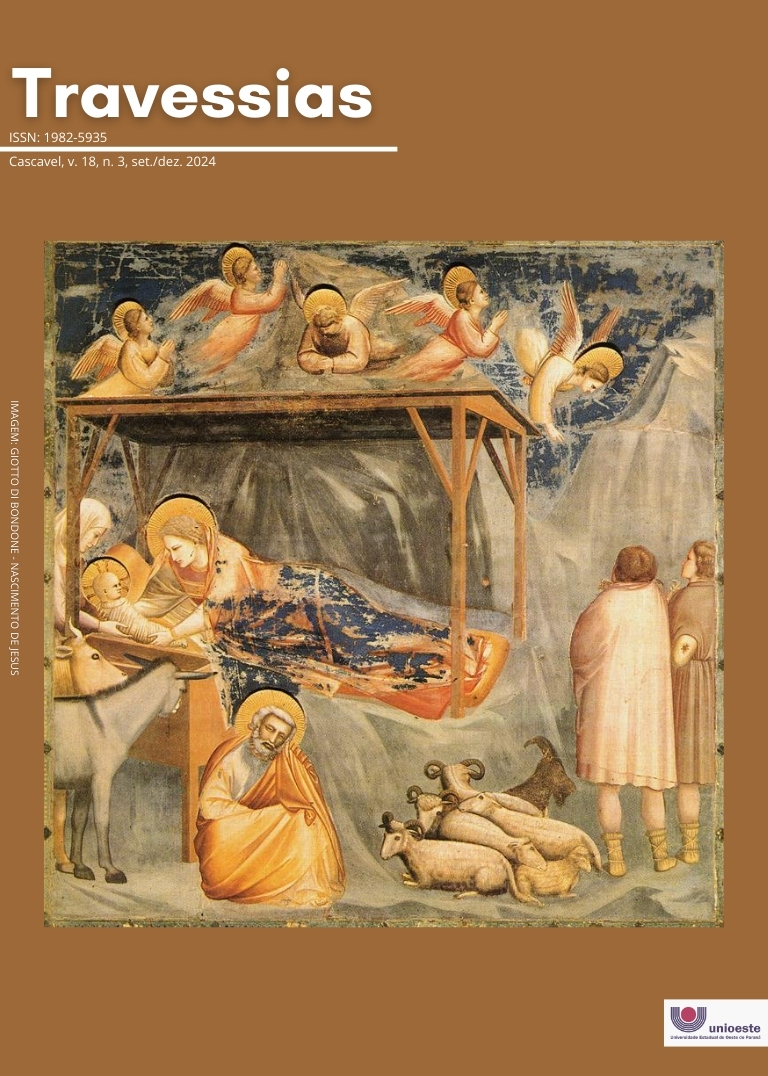Blade Runner
postmodern representations of the gaze and the approximations between the self and the Other in Cyberpunk
DOI:
https://doi.org/10.48075/rt.v18i3.34111Keywords:
Cyberpunk, Blade Runner, alterity, androidsAbstract
The aim of this article is to evaluate how Cyberpunk conceives of postmodernity, especially through its most classic works To this end, the purpose of this article is to investigate the way in which the film Blade Runner promotes debates related to postmodernity, specifically with a view to analyzing the configurations of the characters and the process of rejecting the Other. We believe that, in post-modernity, the opportunity for alterity lies in the analysis and understanding of works from the cyberpunk universe, precisely because they deal with hybrid, peripheralized subjects who are commonly segregated in artistic representations to secondary roles. In this way, these works encapsulate many of the problems and forms of prejudice that are still perceived in post-modern societies. The aim here is to provide a basis for an interpretation of the film Blade Runner as an example of this classic format for the genre, based on a simple premise: how the gazes and designations of the characters absorb and sustain debates about our way of coexisting. The contributions of Dyens (2000), Flisfeder (2021), Jameson (1995) and Zizek (1993) will be used to further this inquiry.
Downloads
References
BACHELARD, Gaston. A Psicanálise do Fogo. Tradução de Paulo Neves. São Paulo: Martins Fontes, 1994.
BLADE Runner The director’s Cut. Direção: Ridley Scott. Produção: Michael Deely e Ridley Scott. Roteiro: Hampton Fancher e David Peoples. Intérpretes: Harrison Ford; Rutger Hauer; Sean Young; Edward James Olmos e outros. Warner Bros; 1991. 1 filme (117 min), som, color. 35 mm.
BRISTOW, Daniel. ‘To Be Homesick with No Place to Go’: The Phantom of the Sinthome and the Joi of Sex. In: NEILL, Calum (org.). Lacanian Perspectives on Blade Runner 2049. Cham: Palgrave Macmillan, 2021, p. 83-102.
CAMUS, Albert. O homem revoltado. Tradução de Valerie Rumjanek. Rio de Janeiro: BestBolso, 2017.
CONTRERAS-KOTERBAY, Scott. In Anxious Anticipation of Our Imminent Obsolescence. In: NEILL, Calum (org.). Lacanian Perspectives on Blade Runner 2049. Cham: Palgrave Macmillan, 2021, p. 167-188.
CRUZ, Décio Torres. Postmodern metanarratives: Blade Runner and literature in the age of image. 1. ed. Londres: Palgrave Macmillan, 2014.
DYENS, Ollivier. Cyberpunk, Technoculture and the Post-Biological Self. CLCWeb: Comparative Literature and Culture: a WWWeb Journal, 2000, p. 01-10.
FLISFEDER, Matthew. Object Oriented Subjectivity: Capitalism and Desire in Blade Runner 2049. In: NEILL, Calum (org.). Lacanian Perspectives on Blade Runner 2049. Cham: Palgrave Macmillan, 2021, p. 121-138.
JAMESON, Fredric. Pós-Modernidade e Sociedade de Consumo. Novos Estudos CEBRAP: São Paulo. n. 12, p. 16-26, 1985.
LÉVINAS, Emmanuel. Totalidade e infinito. Tradução de José Pinto Ribeiro. Lisboa: Edições 70, 1980.
McGOWAN, Todd. Between the Capitalist and the Cop: The Path of Revolution in Blade Runner 2049. In: NEILL, Calum (org.). Lacanian Perspectives on Blade Runner 2049. Cham: Palgrave Macmillan, 2021, p. 53-82.
NEILL, Calum. From Voight-Kampff to Baseline Test: By Way of an Introduction. In: NEILL, Calum (org.). Lacanian Perspectives on Blade Runner 2049. Cham: Palgrave Macmillan, 2021, p. 1-11.
TYRER, Ben. Do Filminds Dream of Celluloid Sheep? Lacan, Filmosophy and Blade Runner 2049. In: NEILL, Calum (org.). Lacanian Perspectives on Blade Runner 2049. Cham: Palgrave Macmillan, 2021, p. 13-40.
ZIZEK, Slavoj. Tarrying With the Negative: Kant, Hegel and the Critique of Ideology. Durham: Duke University Press, 1993.
Downloads
Published
How to Cite
Issue
Section
License
Copyright (c) 2024 Authors keep the copyright and grant the journal the right of first publication, with the work simultaneously licensed under the Creative Commons Attribution License (CC-BY-NC-SA 4.0), which allows sharing the trial with acknowledgment of authorship and initial publication in this journal.

This work is licensed under a Creative Commons Attribution-NonCommercial-ShareAlike 4.0 International License.
Creative Copyright Notice
Policy for Free Access Journals
Authors who publish in this journal agree to the following terms:
1. Authors keep the copyright and grant the journal the right of first publication, with the work simultaneously licensed under the Creative Commons Attribution License, which allows sharing the trial with acknowledgment of authorship and initial publication in this journal.
2. Authors are authorized to take additional contracts separately, for non-exclusive distribution of the work version, published in this journal (eg publish in institutional repository or as a book chapter), with acknowledgment of authorship and initial publication in this journal.
3. Authors are allowed and encouraged to publish and distribute their work online (eg in institutional repositories or on their personal page) at any point before or during the editorial process, as this can generate productive changes, as well as increase both impact and citation of the published trial (See The Effect of Free Access).
Creative Commons License
This work is licensed under a Creative Commons Attribution–NonCommercial-shareaswell 4.0 International License, which allows you to share, copy, distribute, display, reproduce, completely or part of the work, since there is no commercial purpose, and authors and source are cited.



